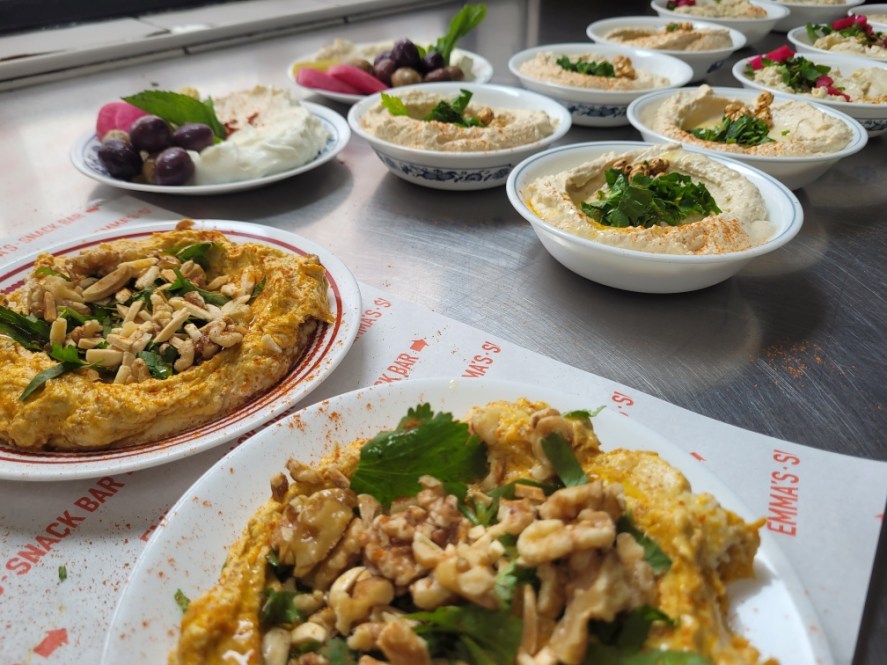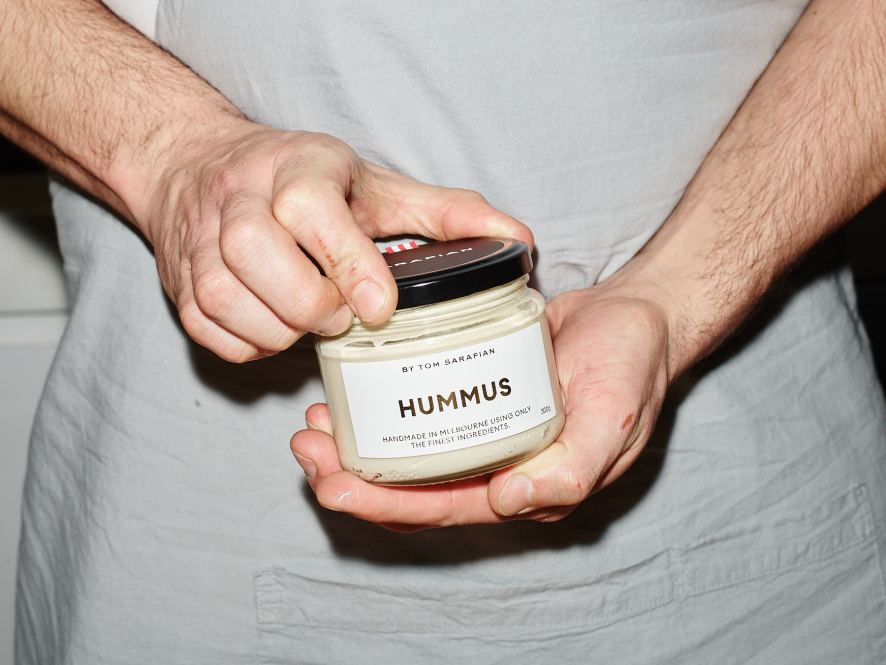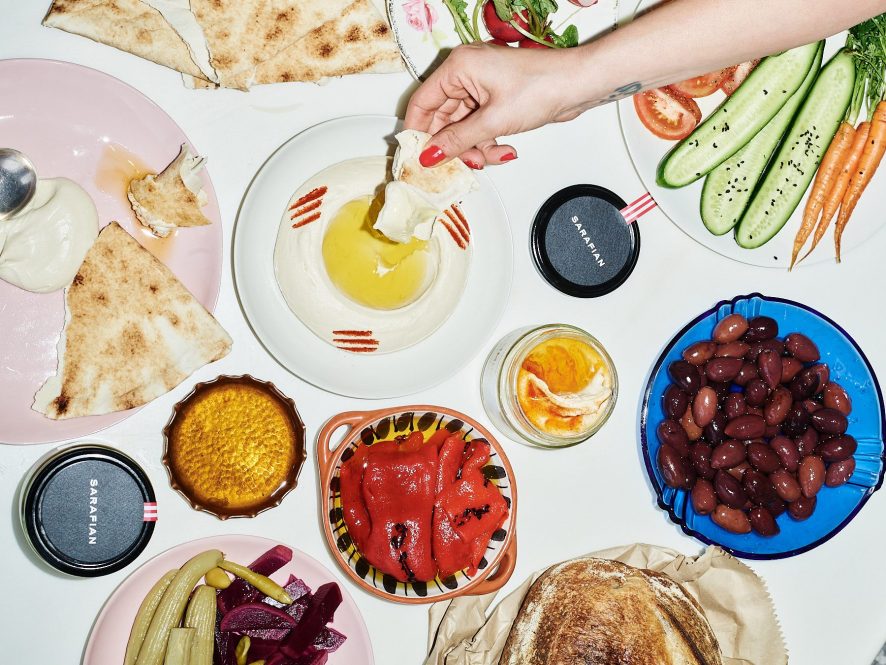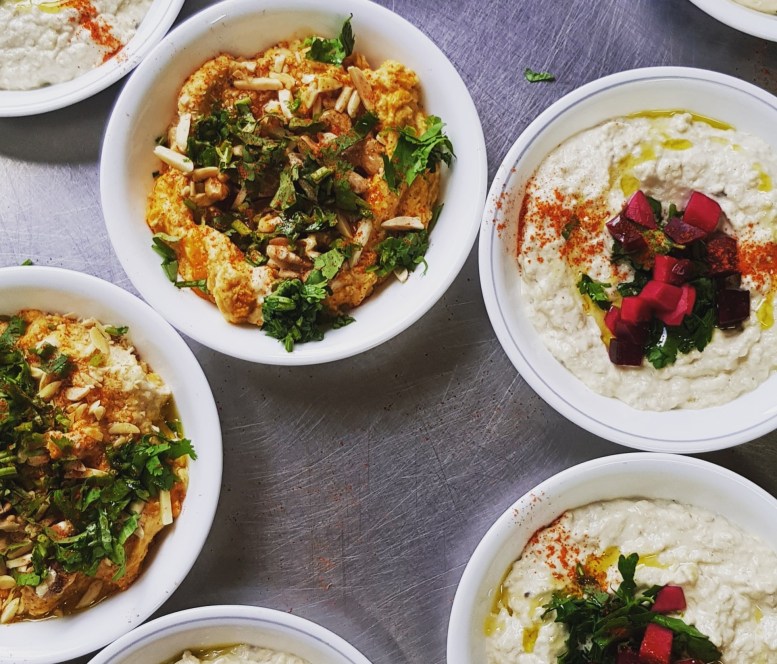By definition, a dip is a condiment that accompanies a variety of foods for added texture or flavour and requires the physical action of dipping for consumption. Dips are in a league of their own compared to sauce, for example, and although there is a fine line between the two, the key role of a dip is to enhance the experience of a meal.
Dip iterations are found in multiple forms from guacamole to salsa, taramasalata and pantzarosalata (beetroot). There is a plethora to choose from, but Middle Eastern dips including hummus and baba ghanoush have long shone in the spotlight. Followed by toum and harissa, the dips are a stalwart when it comes to Middle Eastern cuisine.
Hospitality speaks to Chef Tom Sarafian and Anthony Sofy from Emma’s Snack Bar about the basics of making hummus and baba ghanoush, their ideal dipping vessels and the cultural significance of dips in Middle Eastern cooking.
In Lebanon, dips are not to be taken lightly. They are commonly found at family spreads and can be served with an assortment of goods. Emma’s Snack Bar Owner Anthony Sofy emphasises the importance of dips in everyday Lebanese meals. “In Lebanese culture, dips are a bit more than just dips, they’re big part of our cuisine; we take them very seriously and they’re more substantial,” says Sofy.

Melbourne-based Chef Tom Sarafian also holds dips in high regard, making mention
of his namesake hummus. “You can by all means dip straight into the jar and enjoy it
with breads and crackers, but you can also turn it into a dish topped with things such as ground lamb or barbecued calamari with roast pumpkin in a Middle Eastern-style way,” says Sarafian. “You can’t really do that with other hummus you buy from the supermarket.”
Dips are a big part of the menu at Emma’s, which sees different types of hummus, baba ghanoush and toum listed. Hummus options range from plain to spicy, with the dip playing a staple role in the restaurant’s set banquets and a la carte menu. “The base of the hummus is the same for all three, but then there’s stuff we add such as roasted pumpkin,” says Sofy. “We roast pumpkin with a little bit of spice then we lightly mash it and whip it through.”
Other variations such as the spicy hummus are home recipes that have made their way to the restaurant. “The spicy hummus is a version that we personally made at home, and I just thought it would be interesting to combine it on top of the hummus rather than on the side,” says Sofy.

Sarafian’s hummus was a hit at Melbourne’s Bar Saracen, which closed in January 2021. The former head chef now continues to make the same hummus enjoyed at the restaurant, which is available online and through almost 30 stockists in Melbourne. “It’s real hummus made by chefs and by hand with top-quality ingredients,” says Sarafian. “It takes three days to make and it’s quite a labour-intensive process.”
Toum is a recent addition to the Sarafian brand and marks the beginning of more products to come. “I’m going to introduce these products seasonally; garlic season is
in full swing and it means [toum] might not be around for the whole year,” says the
chef.
“I’ve never used imported garlic, so when the garlic season finishes, it might
not be available until the next season. I’ll continue to do that with harissa in summer
when chillies peak and maybe a baba ghanoush in autumn when eggplants are at their best.”
When making dips, the end result reflects exactly what you put in. While Middle
Eastern dips vary in composition, tahini is prominent. In Australia, the range of
tahini is limited, but Sofy relies on several importers to access premium products.
“Tahini comes from Lebanon; there are a lot of different brands, but the one that
we are using at the moment is Al Kanater,” says Sofy.
For the most part, Sarafian opts for local ingredients, but also seeks out Lebanese
tahini for his hummus and cites Al Nakhil as his go-to. “Out of all the tahini I’ve tried
(and I’ve tried quite a few of them), it’s the most delicious one,” says Sarafian. “It’s just got a beautiful, sweet sort of smoky flavour to it.”

Unlike tahini, chickpeas are in great abundance here in Australia. “We always use Australian chickpeas because they are available and they’re the best ones,” says Sofy. “But stuff like tahini and those types of things have got to come from overseas.”
Sarafian uses Ord River premium chickpeas from Western Australia and says they are the best product for the job. “I found through a lot of trial and error that the bigger the chickpea, the better,” he says. “They seem to soak up more water when you soak them, which results in a softer, creamier chickpea when you cook them.”
There are multiple steps involved in the process of making hummus and baba ghanoush that go beyond just blending together a combination of ingredients. Hummus takes time and the process begins with preparing the chickpeas. “It starts by washing the chickpeas; I soak them for two days and change the water a bunch of times during those two days,” says Sarafian. “The reason being that I cook them in a pressure cooker until they’re very, very soft and then I blitz them.”
The chickpeas are blitzed twice, once right after they’ve been cooked and again the next day. “You blitz it when it’s hot to get it smooth, but then you blitz it when it’s cold and add things the next day, so you don’t get a cooked lemon and garlic flavour, you get a raw, fresh lemon and garlic flavour. And with the tahini, it actually incorporates a lot of air and becomes quite rich and creamy,” says Sarafian. “It’s a bit of a crazy cheffy process, but I think the results are definitely worth it.”
Sarafian’s recipe hasn’t changed for three years, but the retail product required slight adjustments to accommodate larger quantities. “To put it to scale, the machine is about 10 times the size as the one I was using at the restaurant, so I’ve just increased the batch about 10 times, which is pretty hard work handling that much at once,” says Sarafian. “It just took a bit of math and figuring out the best way to achieve the exact same result as what we would serve at Bar Saracen.”
Baba ghanoush takes less time to make, but still requires plenty of effort to get right. “It’s really, really simple, but it’s actually the hardest dip to make because it’s so simple,” says Sofy. “The smallest change will affect it and you’ve lost it.”
The main focus of the dish is eggplant which is cooked over an open flame to achieve depth of flavour. “We’ll flame them on top of a fire, so they’ll blister and burn,” says Sofy. “We peel them and get the flesh out; it’s really smoky and that is the key. If you roast them in the oven, it’s not bad, but you don’t get that smokiness.”
The consistency of baba ghanoush is just as important as the taste. “We’ll put a cup of tahini then salt, lemon and only a touch of water because the eggplant holds a lot of water,” says Sofy. “We put the smoked eggplant in and we don’t blend it to a fine paste, we pulse it and keep it chunky.”

Presentation and plating is the final step. Across the Middle East, dips are shaped
and decorated with a generous slug of oil or dusting of spice. “It’s a pretty traditional method in most Arabic cuisines, especially Lebanese, Egyptian, Syrian and Palestinian, to shape it into a mound or ball on a plate and smooth it out with a warm spoon to create a bit of a dip in the centre,” says Sarafian. “That’s when they fill it with things like ground beef or olive oil in a typical Lebanese style.”
A trademark for hummus is a sprinkling or imprint of paprika. “The paprika is sort of a ’70s retro/sliced lemon/curly parsley touch; it’s something my grandfather used to do,” says Sarafian. “He would dip a fork into water and then into the paprika and garnish the edges of the hummus. That’s why there are three red lines on my hummus label.”
Dip-centric dishes such as bil lahme see spiced ground beef or lamb nestled on a bed of hummus, with similar iterations switching out meat for seafood. “A signature dish of mine was spanner crab and king prawn hummus cooked with lots of spices and chilli garlic,” says Sarafian. “It’s pretty versatile and you can swap out the seafood for roast pumpkin or beetroot.”
More often than not, dips call for accompaniments or vessels to eat them with. “Because it holds such importance to us, we don’t just serve a dip with crackers,” says Sofy. “There is always Lebanese bread any time of the day. If there is dip, there is Lebanese bread.”
For Sofy, variety is a must when eating dip. “In Lebanon, if we are snacking and we want to be really casual or we are having breakfast with family early in the morning, they put dip out on the table, cut up some fresh cucumber, tomato, radishes or something crunchy,” he says. “There are always pickles and chillies which are common things that are always on the table. It could be as simple as that, or it could be lunch or dinner where we have dips with meat.”
The addition of toppings add a textural contrast, with nuts or chillies frequently used. “We don’t go over the top with decorations and they change according to what’s available,” says Sofy. “Sometimes I don’t have a particular herb and I might substitute it; a lot of the time we use double-roasted dried chickpeas on top of the hummus [with] fresh parsley.”
The world of dips is rooted in tradition and represents flavours that are intrinsic to Middle Eastern cuisine. “This is stuff we’ll be doing for generations, and it really hasn’t changed,” says Sofy. “I’d like to think people have noticed that and are thinking, ‘You know what, this is good’. It’s a completely different taste to anything else; you can’t compare hummus or baba ghanoush to any other dip you’ve ever had before.”
Sponsored Content

Discover Dairy Farmers’ range of shredded cheese
Sponsored by Bega

Beachfront Melbourne Club catering & restaurant opportunity
Sponsored by Future Food
Trending Now
Resources
Lorem ipsum dolor sit amet, consectetur adipiscing elit. Fusce ac ornare lectus. Sed bibendum lobortis...
Lorem ipsum dolor sit amet, consectetur adipiscing elit. Fusce ac ornare lectus. Sed bibendum lobortis...
Sign up for our newsletter
